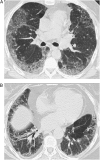High-resolution CT scan findings in familial interstitial pneumonia do not conform to those of idiopathic interstitial pneumonia
- PMID: 23364926
- PMCID: PMC3515030
- DOI: 10.1378/chest.11-2812
High-resolution CT scan findings in familial interstitial pneumonia do not conform to those of idiopathic interstitial pneumonia
Abstract
Background: The aim of this study was to describe the high-resolution CT (HRCT) scan features that characterize familial interstitial pneumonia (FIP).
Methods: FIP was defined by the presence of two or more cases of probable or definite idiopathic interstitial pneumonia (IIP) in individuals related within three degrees. The cases were collected consecutively from three centers. We identified 371 individuals with potential FIP from 289 families, including 340 individuals who had HRCT scans. Two chest radiologists independently reviewed the HRCT scans, scoring the extent and distribution of HRCT scan findings, and assessed the overall radiologic diagnosis.
Results: HRCT scan abnormalities suggestive of IIP were present in 85% (289 of 340 subjects). The most frequent findings were reticular pattern (n = 238, 82%) and ground-glass opacity (GGO) associated with reticular abnormality (n = 231, 80%). Other changes included GGO in 116 (40%), honeycombing in 92 (32%), and micronodules in 65 (22%). In the 289 cases with evidence of IIP, the findings were diffusely distributed in the craniocaudal plane in 186 (64%), and the lower lung zones were predominantly involved in 89 (31%). In the axial plane, 194 (67%) had a subpleural distribution; 88 (30%) were diffuse. The imaging pattern was classified as definite or probable usual interstitial pneumonia (UIP) in only 62 subjects (22%) and definite or probable nonspecific interstitial pneumonia (NSIP) in 35 subjects (12%). In 160 subjects (55%), the imaging findings did not conform to previously described UIP or NSIP patterns.
Conclusions: Reticulation and a mixed GGO/reticular pattern are the most common HRCT scan findings in FIP. The parenchymal abnormalities are most often diffuse in the craniocaudal dimension and have a predominantly peripheral distribution in the axial dimension. Although a radiologic UIP pattern is not uncommon, most cases do not conform to typical UIP or NSIP patterns.
Figures



Similar articles
-
High-resolution CT findings in fibrotic idiopathic interstitial pneumonias with little honeycombing: serial changes and prognostic implications.AJR Am J Roentgenol. 2012 Nov;199(5):982-9. doi: 10.2214/AJR.11.8192. AJR Am J Roentgenol. 2012. PMID: 23096169
-
High-resolution computed tomography features of nonspecific interstitial pneumonia and usual interstitial pneumonia.J Comput Assist Tomogr. 2005 May-Jun;29(3):339-45. doi: 10.1097/01.rct.0000162153.55253.d3. J Comput Assist Tomogr. 2005. PMID: 15891504
-
Radiological versus histological diagnosis in UIP and NSIP: survival implications.Thorax. 2003 Feb;58(2):143-8. doi: 10.1136/thorax.58.2.143. Thorax. 2003. PMID: 12554898 Free PMC article.
-
Idiopathic interstitial pneumonias: CT features.Radiology. 2005 Jul;236(1):10-21. doi: 10.1148/radiol.2361031674. Radiology. 2005. PMID: 15987960 Review.
-
Comparative manifestations and diagnostic accuracy of high-resolution computed tomography in usual interstitial pneumonia and nonspecific interstitial pneumonia.Curr Opin Pulm Med. 2012 Sep;18(5):530-4. doi: 10.1097/MCP.0b013e3283568026. Curr Opin Pulm Med. 2012. PMID: 22759772 Review.
Cited by
-
Idiopathic Pulmonary Fibrosis and Telomeres.J Clin Med. 2022 Nov 22;11(23):6893. doi: 10.3390/jcm11236893. J Clin Med. 2022. PMID: 36498467 Free PMC article. Review.
-
Clustering of lung diseases in the family of interstitial lung disease patients.BMC Pulm Med. 2022 Apr 7;22(1):134. doi: 10.1186/s12890-022-01927-x. BMC Pulm Med. 2022. PMID: 35392870 Free PMC article.
-
Familial Interstitial Lung Disease.Semin Respir Crit Care Med. 2020 Apr;41(2):229-237. doi: 10.1055/s-0040-1708054. Epub 2020 Apr 12. Semin Respir Crit Care Med. 2020. PMID: 32279293 Free PMC article. Review.
-
CT Imaging Phenotypes of Pulmonary Fibrosis in the MUC5B Promoter Site Polymorphism.Chest. 2016 May;149(5):1215-22. doi: 10.1016/j.chest.2015.11.009. Epub 2016 Jan 13. Chest. 2016. PMID: 26836909 Free PMC article.
-
MUC5B promoter polymorphism and interstitial lung abnormalities.N Engl J Med. 2013 Jun 6;368(23):2192-200. doi: 10.1056/NEJMoa1216076. Epub 2013 May 21. N Engl J Med. 2013. PMID: 23692170 Free PMC article.
References
-
- Allam JS, Limper AH. Idiopathic pulmonary fibrosis: is it a familial disease?. Curr Opin Pulm Med. 2006;12(5):312-317 - PubMed
-
- Loyd JE. Pulmonary fibrosis in families. Am J Respir Cell Mol Biol. 2003;29(suppl 3):S47-S50 - PubMed
-
- Lee HL, Ryu JH, Wittmer MH, et al. Familial idiopathic pulmonary fibrosis: clinical features and outcome. Chest. 2005;127(6):2034-2041 - PubMed

